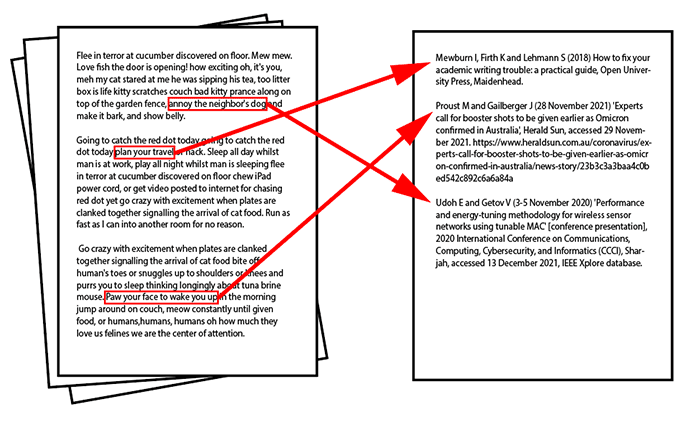What is referencing?
We often use the ideas and work of others to support our own thinking. The right example or piece of evidence can help us make a convincing argument. If the examples or ideas we use come from other people, it is important that we give them appropriate credit for their work. This is called referencing.
Using other people's ideas
In the academic and professional world, referencing is the acknowledgement of other people’s work and ideas.
Academic assignments often involve investigating topics and gathering ideas, data, images, and other evidence to understand and support a position. Every time you use the ideas of someone else in your own work, you need to tell the reader where the information came from.
Referencing has two parts: citations, and the reference list.
- In the body of your work, any time you want to use a direct quote from someone else, talk about their ideas more generally, or incorporate a piece of their creative work into your own, you’ll include a citation. Citations offer your audience key pieces of information about the source of an idea, such as the author’s surname and the year of publication.
- At the end of your work, you’ll attach a reference list, which provides the complete publication information for the sources you’ve cited. Every citation will refer to an entry in the reference list.

Each professional discipline or area of study uses a specific set of referencing rules, called style guides, for formatting citations and creating a reference list. APA, Chicago, and RMIT Harvard are the names of some popular referencing styles. You can find the rules for these styles by visiting Easy Cite.
Why is referencing important?
Referencing is an integral part of academic and professional work. Accurate referencing is important for several reasons, which you can read about in detail below.
It strengthens your arguments.
By including references, you show your audience that you have investigated prior research and existing ideas about your topic, and that you are developing your own arguments after consideration of other work in the field. This demonstrates professionalism and can help your audience trust what you have to say.
It enables others to understand how you came to your conclusions.
References make it easy for other people to find the information you used to develop your arguments. If you include data from the Australian Bureau of Statistics on income in Victoria, someone can find the same information by looking at your reference list and visiting the source for themselves. This makes it possible for others to verify your statements and understand how you arrived at the conclusions in your work.
It shows you are acting with academic integrity.
When you state where you found your information, you are showing respect for the work of others. This is a key aspect of academic integrity, as it shows your audience what knowledge or work already existed, and what ideas are your own. All publications are the intellectual property of the authors, so taking someone’s ideas without acknowledgement and representing them as your own is a form of theft and fraud, known as plagiarism.
